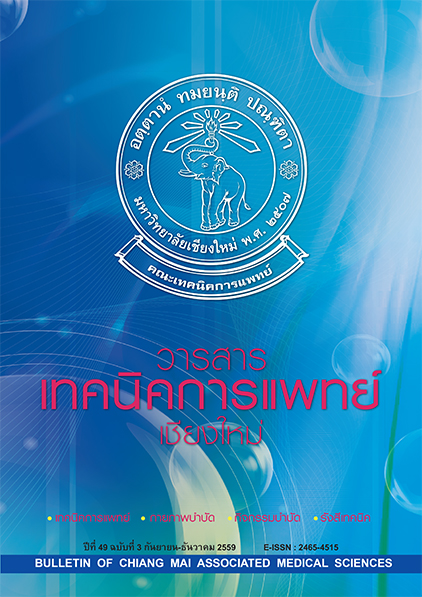The assessment of balance ability in person with type 2 diabetes mellitus
Main Article Content
Abstract
Background: The complications such as decrease strength and endurance of lower extremities, degeneration of
peripheral neuropathy and retinopathy can lead to risk of falling in patients with type 2 diabetes mellitus.
Objectives: The purpose of this study was to assess balance in patient with type 2 diabetes mellitus.
Materials and methods: Two groups of subjects voluntarily participated in the study: patients with type 2 diabetes mellitus (n=30) and normal group (n=30), aged 50-70 years. All subjects undergone Timed Up and Go test (TUG) to measure balance ability.
Results: The results showed that balance ability assessed by TUG in patients with type 2 diabetes mellitus was significantly lower than those in normal group (12.11±2.61 and 9.04±1.04 second, respectively; p<0.0001)
Conclusion: Patient with type 2 diabetes mellitus had higher rate of fall risk than those in normal group. Exercise program to increase balance ability is recommended for type 2 diabetes mellitus patients.
Bull Chiang Mai Assoc Med Sci 2016; 49(2): 338-343. Doi: 10.14456/jams.2016.35
Article Details
Personal views expressed by the contributors in their articles are not necessarily those of the Journal of Associated Medical Sciences, Faculty of Associated Medical Sciences, Chiang Mai University.
References
2. Lohsoonthorn V, Jiamjorsrangsi W. Epidemiology, risk factors, and screening program for type 2 diabetes in Thailand. Health Systems Research Institute; 2007 (in Thai).
3. Nitiyanant W. Dyslipidemia and diabetes. Ruenkaew Printing LTD Publisher; 1992: 129-47 (in Thai).
4. Cressey R. Diabetes mellitus: Basic knowledge and laboratory involved tests. Chiang Mai University Press; 2014 (in Thai).
5. MacGilchrist C, Paul L, Ellis BM, Howe TE, Kennon B, Godwin J. Lower-limb risk factors for falls in people with diabetes mellitus. Diabet Med 2010; 27:162-8. doi: 10.1111/j.1464-5491.2009.02914.x
6. Patel S, Hyer S, Tweed K, Kerry S, Allan K, Rodin A, et al. Risk factors for fractures and falls in older women with type 2 diabetes mellitus. Calcif Tissue Int 2008; 82(2): 87-91. doi: 10.1007/s00223-007-9082-5
7. Netima Koolnee. Management systems for screening diabetic retinopathy province level. Health Systems Research Institute 2012: 11-3 (in Thai).
8. Jalayondeja C. Falls screening by Timed Up and Go. J Med Tech Phy Ther 2014; 26: 5-16 (in Thai).
9. Pontiroli AE, Miele L, Morabito A. Increase of body weight during the first year of intensive insulin treatment in type 2 diabetes: systematic review and meta-analysis. Metabolism 2011; 13:1008-19. doi: 10.1111/j.1463-1326.2011.01433.x
10. American Diabetes Association. Standards of medical care in diabetes. Diabetes Care 2011; 3564-71.


